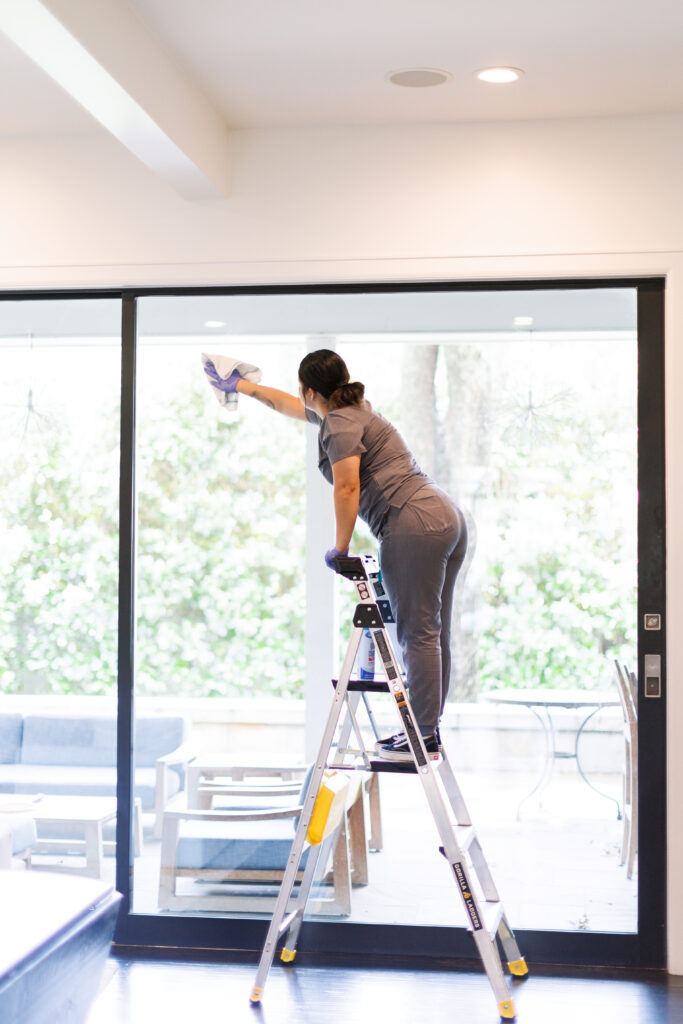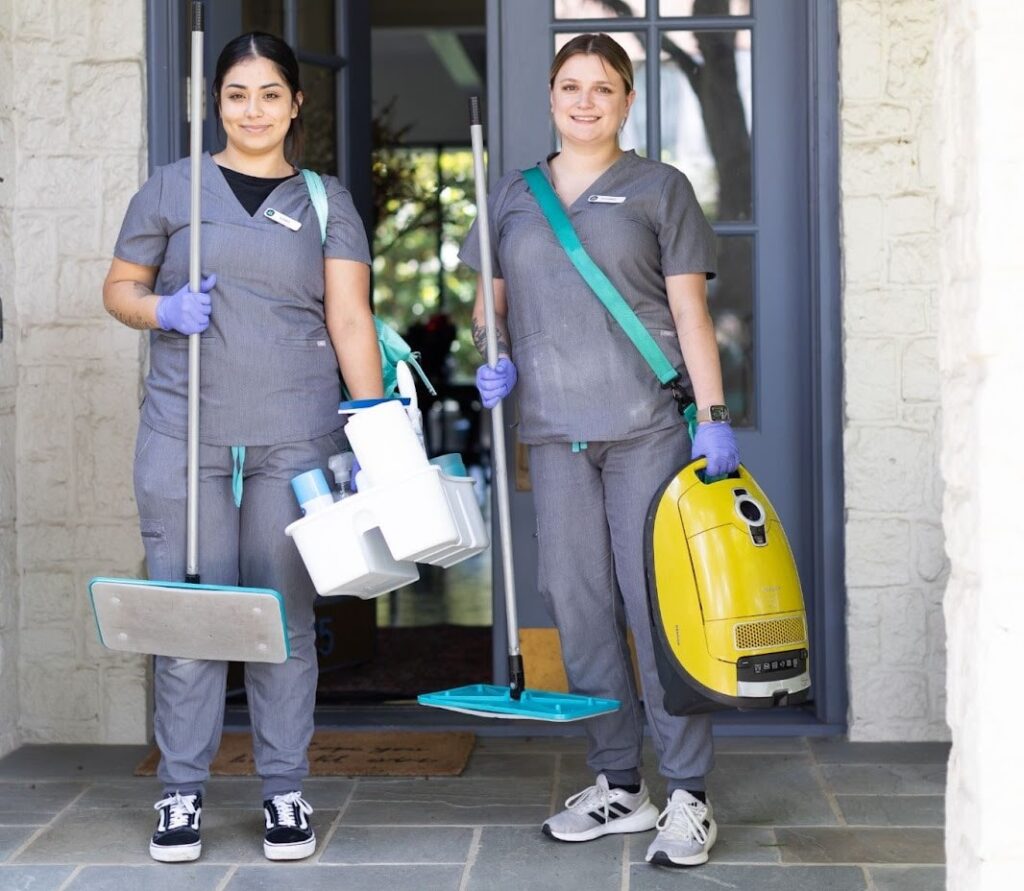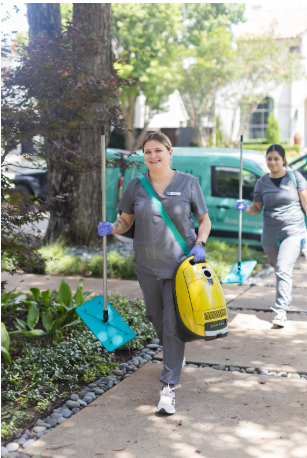Clean windows don’t just uplift the look of a home but also significantly affect our moods and overall well-being. Maintaining that crystal clear look, however, is no easy task. From dust storms and rain showers to pollen coating windows, the number of challenges facing year-round window cleaning changes with each passing season.
At Vella, we know this can feel overwhelming. That’s why we recommend giving your windows a deep clean at least twice a year. The best time is in the spring and fall when the amount of debris or pollen accumulation is the highest.
In this blog, we’re breaking down seasonal challenges to window cleaning one by one so everything from your window sills to screens can keep sparkling all year round.
When Is the Best Time to Clean Windows?
When it comes to window cleaning, it’s better to customize cleaning practices based on the demands of each season. Spring and fall are the best seasons for getting professional deep cleaning done. Usually, winter leaves a build-up of grime and dirt, which is best addressed by cleaning in the spring. In the fall, leaves and dust often pile up on window tracks, and it’s best to get ahead of them before the cold makes it harder.
Summers blow dry dust onto window panes, and winter frost can leave streaks behind, which is why mid-season spot checks are a must. Try to schedule your window cleaning either late in the afternoon or wait for a cloudy morning. Direct sunlight can cause the cleaning solution to dry too quickly, leaving streaks behind on window panes.
Essential Tools & Eco-Safe Cleaning Solutions
While regular window cleaning is essential, it’s often possible to end up doing more harm than good if you’re using the wrong tools. Some of the most essential tools in our window cleaning checklist are:
- Squeegee: Useful for removing water or cleaning solution without leaving any streaks or stains.
- Microfiber cloths: These reusable cloths are highly absorbent and trap dust, making them equally effective for wet and dry cleaning.
- Soft brushes: Used for gently removing dirt and grime without streaking window surfaces.
- Sturdy bucket: A strong, sturdy bucket is essential for mixing water with the cleaning solution.
- Hose attachment: A must-have for both wetting windows to loosen dirt prior to the cleaning and also to wash away dirt after cleaning.
The idea that the best cleaning solutions must contain harsh chemicals is not true. At Vella, we believe in using non-toxic products that prioritize both your well-being and the planet’s. One of our favourites is the Sprayway glass cleaner, which gets out dirt, leaving a streak-free look while also being completely ammonia-free.
Step-by-Step SePolish the glass with vinegar or glass polish for extra shineasonal Window Cleaning Checklist

The way to clean your windows to make a long-lasting difference is to make sure to do it thoroughly. Here is the step-by-step window cleaning checklist we recommend:
1. Prep & Dust Removal
Before you start cleaning, be sure to move any furniture that might be in the way of the windows and take down blinds, curtains, or shades covering the windows. Then, remove the loose dirt and cobwebs from the window tracks and sills with a vacuum cleaner or a soft brush.
2. Cleaning the Glass
Apply the cleaning solution onto the glass and scrub gently with a microfiber cloth. A squeegee is the best choice to wipe away the cleaning solution, dragging from top to bottom. For those tricky edges, try using a dry cloth to prevent streaks.
3. Cleaning Window Tracks & Sills
Clean window tracks and sills are the most overlooked part of the window cleaning checklist, and yet dirty window tracks can make it very difficult to smoothly open and close windows. In order to remove the loose dirt, use a vacuum cleaner to clean the window tracks. Then, use a cloth or cotton swab to deep clean the tracks with a mild solution. Make sure to wipe the tracks completely dry to prevent moisture from building up.
4. Wash & Inspect Screens
Inspecting screens is a key part of ensuring the windows are properly functional. First, remove the screens from the frames. Then, scrub the screen with a cloth dipped in a mild solution. Carefully check the screen to look for any signs of damage and make sure to dry them completely before reinstalling them.
5. Check Seals, Frames & Drainage
Carefully look for signs of cracks or gaps around the window frames. Remove any part of the caulk that appears damaged and seal again or tighten as required.
Pro Tips for Year-Round Sparkle
Keeping your windows clean does not have to be an overwhelming process if you equip yourself with some pro-level tricks at your fingertips.
Here are some of our tips to keep your windows crystal clear even between deep cleans:
- Avoid direct sunlight from falling on your windows to reduce streaks
- Add rubbing alcohol to your winter cleaning solutions to prevent freezing
- Make a habit of scheduling quick mid-season touch-ups
DIY vs. Professional Window Cleaning

Cleaning one’s windows and inventing DIY ideas can often prove to be a deeply satisfying and triumphant experience. Yet in homes with high or hard-to-reach windows or during seasonal deep cleans, a professional touch can save you precious hours and a great deal of headaches.
At Vella, our team is expertly trained and fully dedicated to delivering the eco-friendly, streak-free deep clean of your dreams. You can avail of our service across Texas, including Dallas and Plano.
FAQs
How often should I deep clean my windows?
We recommend deep cleaning twice a year, in the spring and in the fall, and also spot cleanings mid-season.
What’s the best way to clean window tracks?
You can start by vacuuming your window tracks first and then wiping down the tracks with a mild soapy solution.
How do I get streak-free windows?
These are a few pro tips for keeping your windows streak-free: use a squeegee while cleaning, avoid direct sun from hitting your windows, and wipe edges immediately with a dry cloth.
Get Your Seasonal Cleaning Done By Vella
With seasonal deep cleans, the right tools under your belt, and eco-friendly solutions at your fingertips, keeping your windows sparkling all year round is more than achievable. However, our busy schedules often make it impossible to get all these tasks done. So, if you ever feel the need for just a little extra support, don’t hesitate. Sit back and let our professionals do what they’re best at.
Schedule your professional seasonal window cleaning with Vella today.

